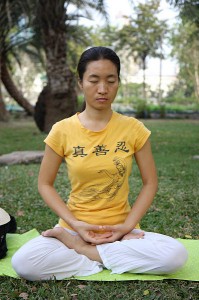Archive for the ‘Common Questions About Meditation’ Category
 What Is A Mantra?
What Is A Mantra?
The word mantra comes from Sanskrit and means “tool/instrument of thought”. They are sounds, syllables, words or groups of words that are repeated with the goal of creating a positive transformation within the person.
At some point or another you will have probably seen a group of Hare Krishna’s chanting Hare Krishna together in a certain order and fashion – this is their mantra.
However mantras do not have to be chanted out loud, they can be voiced internally. They are used this way in Transcendental Meditation with each individual having their own individual mantra unlike the group mantra of the Hare Krishna’s.
If there is an area of your being you would like to develop further then a selecting a mantra relative to this goal can be extremely helpful. For example, if you are someone who often feels anxious then you could choose a mantra like “serenity encompasses me” or, more simply, “peace” to repeat to yourself.
Some find that repeating a mantra helps them slip into a meditative state more easily as it can be focused on more keenly than the act of breathing with contains several different processes.
 What Is The Lotus Position?
What Is The Lotus Position?
The Lotus position is perhaps the best known of the meditation positions. As well as traditional forms of meditation, the Lotus position is also used in yoga which itself is a physical form of meditation. The Lotus position helps to encourage proper breathing and posture.
How To Get Into The Lotus Position
- Begin by seating yourself on the floor (preferably with a mat underneath you) or on a firm mattress.
- Take your left foot and place it on your right thigh.
- Take your right foot and place it on your left thigh.
- Allow your knees to make contact with the ground and centre your torso over your hips.
- Keep your head level.
- Move your shoulders back and rest your hands on your knees.
- Rest your tongue on the roof of your mouth.
It does take a certain amount of flexibility to get yourself into the Lotus position. If you have bad knees then the Lotus position is probably not for you. Instead you could try the Half Lotus where only one foot is rested on you thigh and the other foot is placed underneath the alternate knee. If you cannot manage this then you could simply lie down on your back, perhaps on top of your bed, or sit upright in a comfortable chair.
Below you will find a video guide on how to get into the lotus position correctly.
 What Are The Benefits Of Meditation?
What Are The Benefits Of Meditation?
Meditation provides a number of benefits in many different areas – physical, mental and spiritual. Even if you are someone who doesn’t believe in the spiritual side of life the physical and mental benefits of meditation cannot be denied.
Physical Benefits of Meditation
- Lowers blood pressure.
- Increases the rate of healing.
- Enhances energy and vitality.
- Improves the immune system.
- Reduces muscle tension.
- Decreases anxiety.
- Overall relaxing effect.
Mental Benefits of Meditation
- Heightens sense of focus and concentration.
- Balances the emotional process.
- Enhances creative thought process.
- Improves short term memory functions.
- Keeps the mind active, reducing brain age.
- Become more accepting of others.
- Reduces feelings of aggression.
Spiritual Benefits of Meditation
- Enter a higher state of consciousness.
- Communicate with the collective consciousness of humanity.
- Become one with your surroundings.
- Harmonizes body, mind and spirit.
- Access to spiritual knowledge.
- Live “in the moment”.
- Ultimate enlightenment.
By being more specific on each point I could have probably come up with over a hundred benefits of meditation. Perhaps one of the biggest benefits that I haven’t mentioned already though is that it never need cost you any money to meditate.